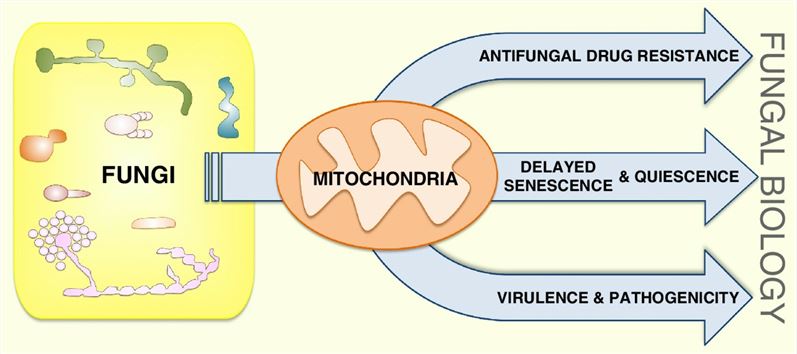Mitochondria are membrane-enclosed organelles found in most eukaryotic cells that contain their genetic material. In addition to providing cellular energy, mitochondria are associated with energy metabolism, oxidative stress, cell signaling, and cell death, and to some extent, control the life and death of eukaryotic cells. The great metabolic diversity and survival strategies of fungi make their mitochondria of special evolutionary interest. Mitochondrial DNA (mtDNA) is attractive for the systematic study of fungi because it is a small, easily isolated, and well-studied molecule. With the development of novel sequencing methods, the number of fungal mitochondrial genomes continues to increase. In fungi, mtDNA is widely used to address questions of taxonomy, mitochondrial origin, and horizontal gene transfer.
 Fig. 1. Mitochondria play a central role in fungal senescence and quiescence. (Chatre L et al., 2014)
Fig. 1. Mitochondria play a central role in fungal senescence and quiescence. (Chatre L et al., 2014)
Services
The mushroom mitochondrial genome sequence is widely used in evolutionary and population studies and provides biological functions regarding energy required for cell growth. Our experts have determined the complete mitochondrial genomes of different mushrooms using a combination of advanced sequencing technologies to help you analyze their gene content and repetitive sequences and identify open reading frames in intergenic regions and intron sequences. Here, Lifeasible offers specialized mitochondrial genetics services for mushrooms to characterize the genetic content and differential gene expression of mushroom mitochondrial genomes. Our services can assemble and annotate the complete mitochondrial genomes of a wide range of mushrooms, providing genetic information for future breeding programs.
Lifeasible develops customized mitochondrial genome analysis processes for mushrooms.
- Mitochondrial DNA preparation.
- Genome annotation.
- Codon usage bias and repetitive sequence analysis.
- Phylogenetic tree construction.
Advantages of Our Services
- Provide valuable information for the evolution of mushroom mtDNA.
- Allow comparative analysis of the mitochondrial gene order of a particular genome and other closely related species.
- Provide transcriptomic data for gene annotation, expression analysis, and detection of transcriptionally active regions (TARs).
- Large number of molecular markers available.
- Highly supported phylogenetic trees can be obtained using combinatorial mitochondrial gene sets.
As the "second genome" of eukaryotes, the mitochondrial genome plays an important role in eukaryotic aging, mortality, disease development, and resistance to disease. The availability of the mitochondrial genome of specialty mushrooms will form the basis of genetic breeding programs and enhance our understanding of the evolution of this species. If you are interested in our services, please contact us.
Reference
- Chatre L, Ricchetti M. (2014) Are mitochondria the Achilles’ heel of the Kingdom Fungi?[J]. Current opinion in microbiology. 20: 49-54.
For research or industrial raw materials, not for personal medical use!


 Fig. 1. Mitochondria play a central role in fungal senescence and quiescence. (Chatre L et al., 2014)
Fig. 1. Mitochondria play a central role in fungal senescence and quiescence. (Chatre L et al., 2014) 